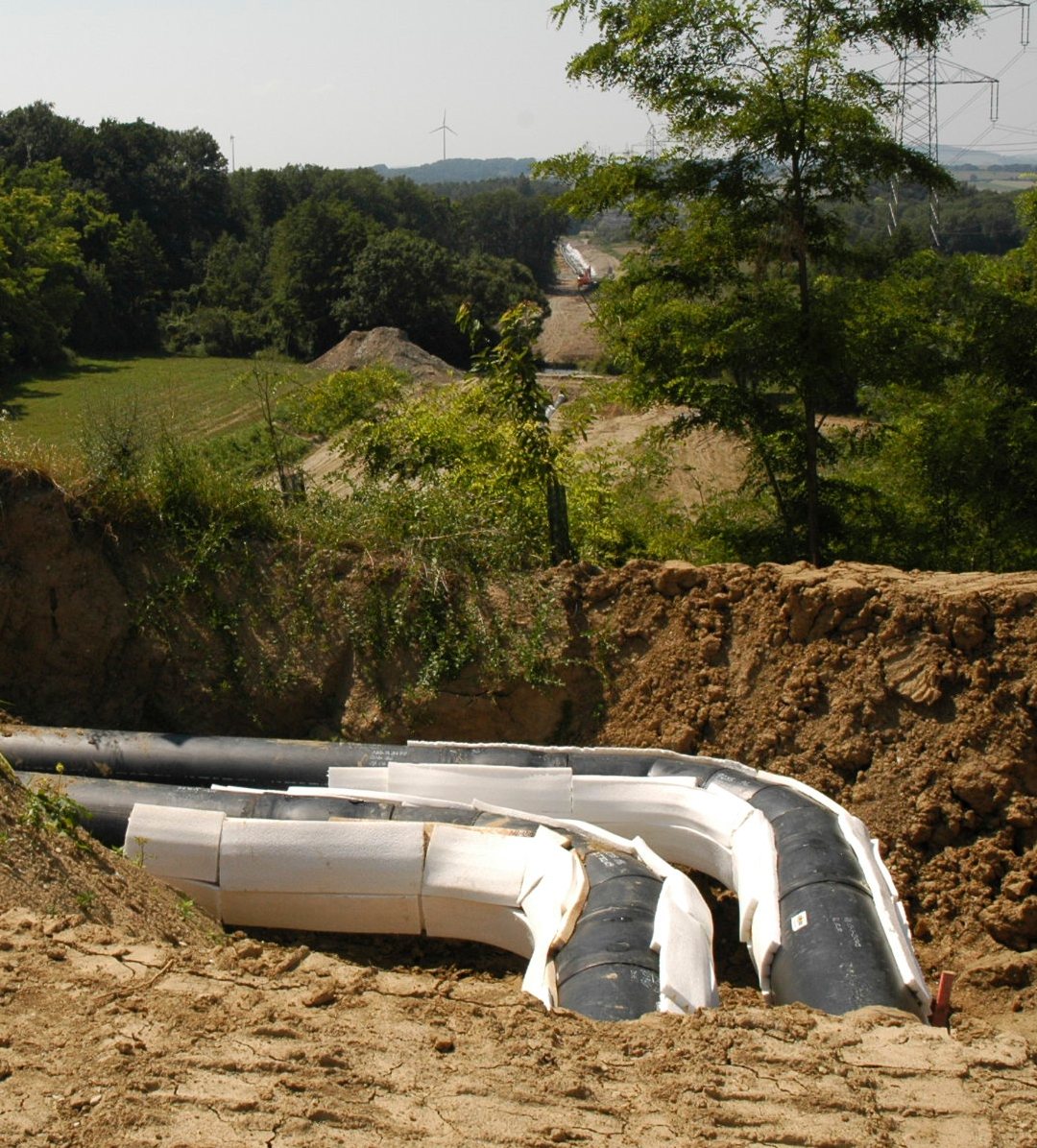Insulated pipes on:
[Wikipedia]
[Google]
[Amazon]

 Insulated pipes (called also preinsulated pipes or bonded pipe ) are widely used for
Insulated pipes (called also preinsulated pipes or bonded pipe ) are widely used for

 Insulated pipes (called also preinsulated pipes or bonded pipe ) are widely used for
Insulated pipes (called also preinsulated pipes or bonded pipe ) are widely used for district heating
District heating (also known as heat networks or teleheating) is a system for distributing heat generated in a centralized location through a system of insulated pipes for residential and commercial heating requirements such as space heating a ...
and hot water supply. They consist of a steel pipe
A pipe is a tubular section or hollow cylinder, usually but not necessarily of circular cross-section, used mainly to convey substances which can flow — liquids and gases (fluids), slurries, powders and masses of small solids. It ...
called "service pipe", a thermal insulation layer and an outer casing. The main purpose of such pipes is to maintain the temperature
Temperature is a physical quantity that expresses quantitatively the perceptions of hotness and coldness. Temperature is measurement, measured with a thermometer.
Thermometers are calibrated in various Conversion of units of temperature, temp ...
of the fluid inside the service pipes. Insulated pipes are commonly used for transport of hot water from district heating plant
A heating plant, also called a physical plant, or steam plant, generates thermal energy in the form of steam for use in district heating applications. Unlike combined heat and power installations which produce thermal energy as a by-produc ...
s to district heating networks and for distribution of hot water inside district heating networks.
Thermal insulation material usually used is polyurethane
Polyurethane (; often abbreviated PUR and PU) refers to a class of polymers composed of organic units joined by carbamate (urethane) links. In contrast to other common polymers such as polyethylene and polystyrene, polyurethane is produced from ...
foam or similar, with a thermal conductivity
The thermal conductivity of a material is a measure of its ability to conduct heat. It is commonly denoted by k, \lambda, or \kappa.
Heat transfer occurs at a lower rate in materials of low thermal conductivity than in materials of high thermal ...
λ50 of about 0.024–0.033 W/(m·K). Outer casing is usually made of high-density polyethylene
High-density polyethylene (HDPE) or polyethylene high-density (PEHD) is a thermoplastic polymer produced from the monomer ethylene. It is sometimes called "alkathene" or "polythene" when used for HDPE pipes. With a high strength-to-density ratio, ...
(HDPE). Preinsulated pipes for district heating are described in European standards EN 253 and EN 15698-1. EN 253 describes "District heating pipes - Bonded single pipe systems for directly buried hot water networks - Factory made pipe assembly of steel service pipe, polyurethane thermal insulation and a casing of polyethylene". EN 15698-1 describes "District heating pipes - Bonded twin pipe systems for directly buried hot water networks - Factory made twin pipe assembly of steel service pipes, polyurethane thermal insulation and one casing of polyethylene". Both standards don't give "short names" or abbreviations for described pipes.
According to EN 253:2019 & EN 15698-1:2019, pipes must be produced to work at constant temperature of for 30 years. Thermal conductivity λ50 in unaged condition shall not exceed 0.029 W/(m·K). Both standards describe three insulation thickness levels. Both standards require use of polyurethane foam for thermal insulation and HDPE for casing.
Insulated pipelines are usually assembled from pipes of , , or in length, directly buried in soil
Soil, also commonly referred to as earth or dirt
Dirt is an unclean matter, especially when in contact with a person's clothes, skin, or possessions. In such cases, they are said to become dirty.
Common types of dirt include:
* Debri ...
in depths of commonly .
See also
* Heat conduction *Heat transfer
Heat transfer is a discipline of thermal engineering that concerns the generation, use, conversion, and exchange of thermal energy (heat) between physical systems. Heat transfer is classified into various mechanisms, such as thermal conduction, ...
* Heat transfer mechanisms
* R-value
* Specific Heat
In thermodynamics, the specific heat capacity (symbol ) of a substance is the heat capacity of a sample of the substance divided by the mass of the sample, also sometimes referred to as massic heat capacity. Informally, it is the amount of heat t ...
* Thermal bridge
A thermal bridge, also called a cold bridge, heat bridge, or thermal bypass, is an area or component of an object which has higher thermal conductivity than the surrounding materials, creating a path of least resistance for heat transfer.Gorse, Chr ...
* Thermal contact conductance
In physics, thermal contact conductance is the study of heat conduction between solid or liquid bodies in thermal contact. The thermal contact conductance coefficient, h_c, is a property indicating the thermal conductivity, or ability to conduct he ...
* Thermal diffusivity
In heat transfer analysis, thermal diffusivity is the thermal conductivity divided by density and specific heat capacity at constant pressure. It measures the rate of transfer of heat of a material from the hot end to the cold end. It has the SI ...
* Thermal resistance in electronics
Thermal resistance is a heat property and a measurement of a temperature difference by which an object or material resists a heat flow. Thermal resistance is the reciprocal of thermal conductance.
* (Absolute) thermal resistance ''R'' in kelvi ...
* Thermocouple
A thermocouple, also known as a "thermoelectrical thermometer", is an electrical device consisting of two dissimilar electrical conductors forming an electrical junction. A thermocouple produces a temperature-dependent voltage as a result of th ...
References
{{reflist Energy conservation Heating, ventilation, and air conditioning Piping Residential heating de:Kunststoffmantelverbundrohr